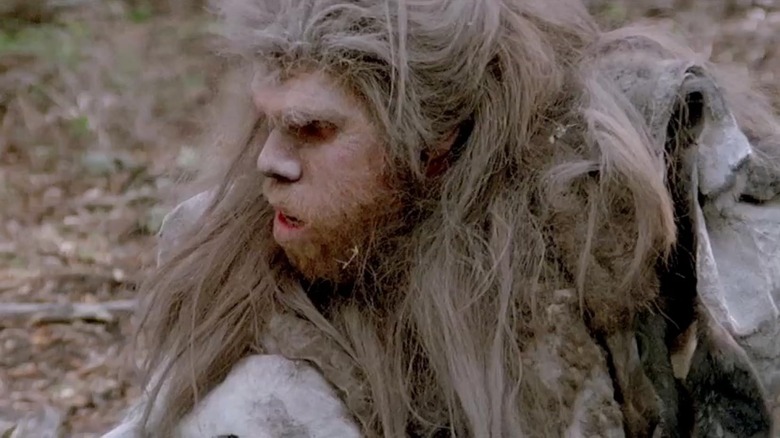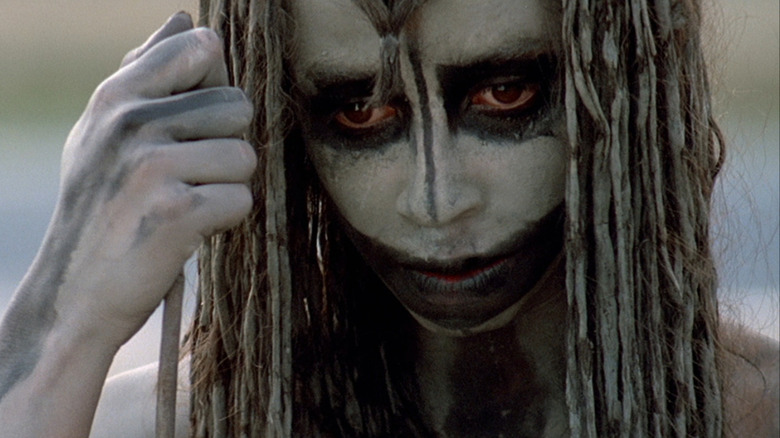Ron Perlman's Oscar-Winning Fantasy Movie Is An Underrated Classic You Have To Watch
Jean-Jacques Annaud's 1981 film "Quest of Fire," based on the 1911 novel by J.-H. Rosny, is set about 80,000 years in the past, back in the Middle Paleolithic period. It's a fictionalized account of a caveman tribe called the Ulam, a group that is still figuring out spoken languages and how to make fire. The Ulam have access to fire, but only by salvaging branches that are still burning after, say, a lightning strike. They have to keep the fire burning constantly or risk freezing.
When tussling with a less-evolved tribe of protohumans, the Ulam lose their fire in a swamp. Their only recourse is to select their three bravest members — Naoh (Everett McGill), Amoukar (the great Ron Perlman), and Gaw (Nameer El-Kadi) — to set out across the continent to look for more. Along the way, they run afoul of a saber-toothed cat, attract the ire of a species of ape-like cannibals, and eventually fall into the company of a woman named Ika (Rae Dawn Chong). Ika comes from the Ivaka, a more advanced tribe that has already mastered verbal language, possesses more advanced spear-like weapons, and, yes, can actually start fires.
Anthony Burgess, the author of "A Clockwork Orange," was hired to serve as a special language consultant for "Quest for Fire," while the anthropologist Desmond Morris provided the production with info regarding how cavemen might have moved and communicated via sign language. Although "Quest for Fire" is constructed like a Hero's Journey-style fantasy adventure fable, its smoky photography (by Claude Agostini) and excellent cavemen performances make it feel like an historical document. It's not accurate (as scientists noted at the time), but it felt accurate to a layperson and even won an Academy Award for its makeup.
Quest for Fire felt historically accurate (even though it wasn't)
When it hit theaters, several scientists stepped forward to discuss how historically inaccurate "Quest for Fire" was. Famously, a professional linguist named Philip Lieberman reviewed "Quest for Fire" for Brown University's American Anthropologist newsletter, pointing out that tribes with such varying levels of technology wouldn't be living so closely to one another. If one tribe could literally walk to a tribe that could make fire, then they would've known about each other's fire-making abilities. He also pointed out that the caveman actors all grunted and moved like apes, which wouldn't have been the case in the Middle Paleolithic period. Homo sapiens were already Homo sapiens.
More recent research indicates that Homo sapiens and Neanderthals, two separate species, likely interacted regularly and may have inter-mated. "Quest for Fire" might have been accurate by accident.
Critics mostly loved "Quest for Fire," as evidenced by its 88 percent critics' score (against 25 reviews) on Rotten Tomatoes. Giving it three-and-a-half out of four stars in his own review, Roger Ebert wrote that the film's premise was absurd (he felt it would be hard to sympathize for grunting, borderline nonverbal cavemen), but he admitted to becoming engaged in the cavemen's journey by the end. Even Ridley Scott counts it as one of his all-time favorite movies, with the "Alien" and "Blade Runner" director calling it "so clever" and "so brilliant" in an interview with Letterboxd.
Overall, "Quest for Fire" is pretty good. It has the tone of a 1980s fantasy adventure film, but the texture of a prestige picture intended for grownups. It was a hit at the time, but it isn't discussed as much by younger generations of moviegoers. It's currently available to stream on Hoopla, and it's definitely worth a look.

